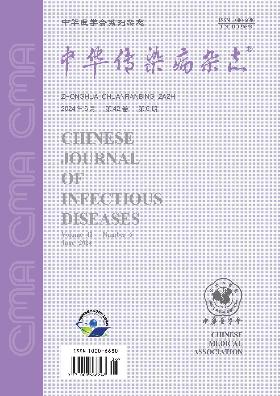Clinical application of neutrophil-to-lymphocyte ratio in predicting the prognosis of H7N9 avian influenza
引用次数: 0
Abstract
Objective To explore the predictive value of neutrophil-to-lymphocyte ratio on the prognosis of H7N9 avian influenza. Methods A retrospective analysis was conducted on 28 H7N9 avian influenza patients (treatment group) at the First Affiliated Hospital of Soochow University from April 2013 to January 2016. Thirty healthy physical examiners in the same period were enrolled as the healthy control group. The 28 patients were followed up for half a year and divided into the improvement group (18 cases) and the death group (10 cases) according to the clinical prognosis. Inflammatory indicators including white blood cells (WBC), neutrophil (N), lymphocyte (L), monocytes (M), platelet (PLT), creatine kinase (CK), lactate dehydrogenase (LDH), high sensitive C reactive protein were collected at day 1, day 3 and week 1 of admission. Calculation of neutrophil-to-lymphocyte ratio (NLR), platelet-to-lymphocyte ratio (PLR), lymphocyte-to-monocyte ratio (LMR), ΔNLR3 (day 3 of admission NLR-on day 1 of admission NLR), ΔNLR7 (week 1 of admission NLR -day 3 of admission NLR) and so on calculating ΔPLR3, ΔPLR7, ΔLMR3, ΔLMR7. Differences of the above indicators between the improvement group and death group were compared. The measurement data with normal distribution were tested by t-test of two independent samples, and the count data with non-normal distribution were tested by Mann-Whitney U-test. Univariate and multivariate logistic regression analysis to explore the prognostic factors and the working characteristic curve of subjects was used to evaluate the predictive value of inflammatory response indexes for H7N9 avian influenza death. Results In the treatment group, the baseline WBC, L, N, PLT, the proportion of lymphocytes, neutrophils, monocytes, and NLR, PLR, and LMR were all statistically different compared with the healthy control group (all P<0.01). After treatment, day 3 NLR, ΔNLR3 in improvement group were both significantly decreased to 10.93 (15.71) and 0.87 (-15.63), respectively when compared with death group (17.62[23.63] and 7.42[22.68], respectively) (Z=-2.16 and -2.014, respectively, both P<0.05). Day 7 NLR, ΔNLR7 in improved group were 6.51 (13.23) and -0.37 (-12.38), respectively, which were both lower than those of death group (27.90 [25.64] and 11.54 [-26.22]) with statistically significant differences (Z=-2.444 and -2.111, respectively, both P<0.05). Multivariate logistic regression analysis indicates that ΔNLR3 is the main factor that affects the prognosis of the H7N9 infection (odds ratio [OR]=1.153, 95% confidence interval [CI]: 1.052-1.263, P=0.002). Reciver operating characteristic curve analysis showed that the area under the curve was 0.733 (95% CI: 0.532-0.935, P=0.044). Based on the principle of Youden index, the cut-off value of ΔNLR3 to predict the death risk of H7N9 avian influenza was 5.453 with sensitivity of 0.700 and the specificity of 0.722. The mortality was higher when ΔNLR3 was higher than 5.453. Conclusions Dynamic monitoring NLR, especially ΔNLR3 may reflect the condition and prognosis of H7N9 infection, which is an independent predictor of death. Key words: H7N9 avian influenza virus; Neutrophil lymphocyte ratio; Prognosis中性粒细胞与淋巴细胞比值在预测H7N9禽流感预后中的临床应用
目的探讨中性粒细胞与淋巴细胞比值对H7N9禽流感预后的预测价值。方法对2013年4月至2016年1月东吴大学附属第一医院收治的28例H7N9禽流感患者(治疗组)进行回顾性分析。同期30名健康体检者作为健康对照组。28例患者随访半年,根据临床预后分为好转组(18例)和死亡组(10例)。在入院第1天、第3天和第1周收集炎症指标,包括白细胞(WBC)、中性粒细胞(N)、淋巴细胞(L)、单核细胞(M)、血小板(PLT)、肌酸激酶(CK)、乳酸脱氢酶(LDH)、高敏C反应蛋白。计算中性粒细胞与淋巴细胞的比率(NLR)、血小板与淋巴细胞的比例(PLR)、淋巴细胞与单核细胞的比率(LMR)、ΔNLR3(入院第3天,入院第1天,NLR)和ΔNLR7(入院第1周,NLR第3天),依此计算ΔPLR3、ΔPLR7、ΔLMR3、ΔLMR7。比较改善组和死亡组上述指标的差异。正态分布的测量数据通过两个独立样本的t检验进行检验,非正态分布计数数据通过Mann-Whitney U检验进行检验。采用单因素和多因素logistic回归分析探讨受试者的预后因素和工作特征曲线,评价炎症反应指标对H7N9禽流感死亡的预测价值。结果治疗组基线WBC、L、N、PLT、淋巴细胞、中性粒细胞、单核细胞比例、NLR、PLR和LMR与健康对照组相比均有统计学差异(均P<0.01),与死亡组相比(分别为17.62[23.63]和7.42[22.68])(Z=-2.16和-2.014,均P<0.05)。改善组第7天NLR、ΔNLR7分别为6.51(13.23)和-0.37(-12.38),均低于死亡组(27.90[25.64]和11.54[-26.22]),差异有统计学意义(Z=-2.444和-2.111,均P<0.05)。多元logistic回归分析表明ΔNLR3是影响H7N9感染预后的主要因素(比值比[OR]=1.153,95%可信区间[CI]:1.052-1.263,P=0.002)操作特征曲线分析显示,曲线下面积为0.733(95%CI:0.532-0.935,P=0.044)。根据尤登指数原理,ΔNLR3预测H7N9禽流感死亡风险的临界值为5.453,灵敏度为0.700,特异性为0.722。ΔNLR3高于5.453时死亡率较高。结论动态监测NLR,尤其是ΔNLR3,可以反映H7N9感染的病情和预后,是死亡的独立预测指标。关键词:H7N9禽流感病毒;中性粒细胞淋巴细胞比率;预后
本文章由计算机程序翻译,如有差异,请以英文原文为准。
求助全文
约1分钟内获得全文
求助全文
来源期刊
自引率
0.00%
发文量
5280
期刊介绍:
The Chinese Journal of Infectious Diseases was founded in February 1983. It is an academic journal on infectious diseases supervised by the China Association for Science and Technology, sponsored by the Chinese Medical Association, and hosted by the Shanghai Medical Association. The journal targets infectious disease physicians as its main readers, taking into account physicians of other interdisciplinary disciplines, and timely reports on leading scientific research results and clinical diagnosis and treatment experience in the field of infectious diseases, as well as basic theoretical research that has a guiding role in the clinical practice of infectious diseases and is closely integrated with the actual clinical practice of infectious diseases. Columns include reviews (including editor-in-chief reviews), expert lectures, consensus and guidelines (including interpretations), monographs, short monographs, academic debates, epidemic news, international dynamics, case reports, reviews, lectures, meeting minutes, etc.

 求助内容:
求助内容: 应助结果提醒方式:
应助结果提醒方式:


